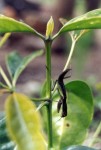 Carolyn
Cook, an anthropologist who's worked with the Amungme
tribe for over a decade, took us on a tour of the Pandanus
Project near the Amungme
village of Banti. Dr. Cook's idea is to
help the Papuans develop more sustainable agriculture that will provide
tradable goods and so help the Papuans become less dependent on the
mine (because the mine won't last forever!). Freeport helps with
some of the logistics, etc. of the project Carolyn
Cook, an anthropologist who's worked with the Amungme
tribe for over a decade, took us on a tour of the Pandanus
Project near the Amungme
village of Banti. Dr. Cook's idea is to
help the Papuans develop more sustainable agriculture that will provide
tradable goods and so help the Papuans become less dependent on the
mine (because the mine won't last forever!). Freeport helps with
some of the logistics, etc. of the project
|
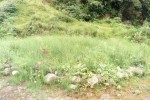 This is the site of a Papuan hut
before the war between tribes over who could live near the mine.
The mine is a source of jobs, wealth, and food, and the tribe closes to
the site would get the lion's share of the goods, so the Dani, Moni,
Ekari, Amungme, and Damal tribes fought for the land. Kal Muller
wrote an excellent article describing the events of that war. The
Amungme-Damal alliance killed seven Dani warriors and the
Dani-Moni-Ekari alliance killed two Damal warriors. Because it is
taboo to live on land or eat food grown on land where blood was spilled
in battle, the huts in the valley had to be evacuated. Apparently
this taboo means that Amungme will not eat food from this site for
many, many decades in the future, but that doesn't prevent them from
selling food from this blood tainted land to lowland Papuans who
wouldn't know any better! This is the site of a Papuan hut
before the war between tribes over who could live near the mine.
The mine is a source of jobs, wealth, and food, and the tribe closes to
the site would get the lion's share of the goods, so the Dani, Moni,
Ekari, Amungme, and Damal tribes fought for the land. Kal Muller
wrote an excellent article describing the events of that war. The
Amungme-Damal alliance killed seven Dani warriors and the
Dani-Moni-Ekari alliance killed two Damal warriors. Because it is
taboo to live on land or eat food grown on land where blood was spilled
in battle, the huts in the valley had to be evacuated. Apparently
this taboo means that Amungme will not eat food from this site for
many, many decades in the future, but that doesn't prevent them from
selling food from this blood tainted land to lowland Papuans who
wouldn't know any better! |
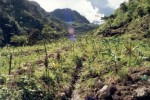 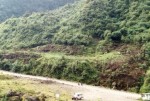 Carolyn directs Amungme workers as
they clear small plots of land on the steep hillsides on which they'll
grow pandanus nuts (and coffee). Apparently the pandanus plant
also provides useful leaves and grows well in this climate. Carolyn directs Amungme workers as
they clear small plots of land on the steep hillsides on which they'll
grow pandanus nuts (and coffee). Apparently the pandanus plant
also provides useful leaves and grows well in this climate. |
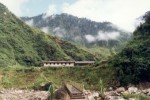 The nursery headquarters is a
building in which topsoil is screened for planting seeds and storing
young plants prior to transplanting into the fields. Stacie
helped the Papuans with their screening when we visited - an enjoyable
way to pass time, actually, because the process involves four or five
people sitting around one-meter square sieves and rooting through the
soil with their fingers and banter about whatever happens to come to
mind. The nursery headquarters is a
building in which topsoil is screened for planting seeds and storing
young plants prior to transplanting into the fields. Stacie
helped the Papuans with their screening when we visited - an enjoyable
way to pass time, actually, because the process involves four or five
people sitting around one-meter square sieves and rooting through the
soil with their fingers and banter about whatever happens to come to
mind. |
  Things grow well in the wet Papuan
highlands. It's sometimes difficult for the untrained eye (i.e.,
mine) to see where agricultural fields end and jungle begins. Things grow well in the wet Papuan
highlands. It's sometimes difficult for the untrained eye (i.e.,
mine) to see where agricultural fields end and jungle begins. |
 Carolyn
Cook, an anthropologist who's worked with the Amungme
tribe for over a decade, took us on a tour of the Pandanus
Project near the Amungme
village of Banti. Dr. Cook's idea is to
help the Papuans develop more sustainable agriculture that will provide
tradable goods and so help the Papuans become less dependent on the
mine (because the mine won't last forever!). Freeport helps with
some of the logistics, etc. of the project
Carolyn
Cook, an anthropologist who's worked with the Amungme
tribe for over a decade, took us on a tour of the Pandanus
Project near the Amungme
village of Banti. Dr. Cook's idea is to
help the Papuans develop more sustainable agriculture that will provide
tradable goods and so help the Papuans become less dependent on the
mine (because the mine won't last forever!). Freeport helps with
some of the logistics, etc. of the project This is the site of a Papuan hut
before the war between tribes over who could live near the mine.
The mine is a source of jobs, wealth, and food, and the tribe closes to
the site would get the lion's share of the goods, so the Dani, Moni,
Ekari, Amungme, and Damal tribes fought for the land. Kal Muller
wrote an excellent article describing the events of that war. The
Amungme-Damal alliance killed seven Dani warriors and the
Dani-Moni-Ekari alliance killed two Damal warriors. Because it is
taboo to live on land or eat food grown on land where blood was spilled
in battle, the huts in the valley had to be evacuated. Apparently
this taboo means that Amungme will not eat food from this site for
many, many decades in the future, but that doesn't prevent them from
selling food from this blood tainted land to lowland Papuans who
wouldn't know any better!
This is the site of a Papuan hut
before the war between tribes over who could live near the mine.
The mine is a source of jobs, wealth, and food, and the tribe closes to
the site would get the lion's share of the goods, so the Dani, Moni,
Ekari, Amungme, and Damal tribes fought for the land. Kal Muller
wrote an excellent article describing the events of that war. The
Amungme-Damal alliance killed seven Dani warriors and the
Dani-Moni-Ekari alliance killed two Damal warriors. Because it is
taboo to live on land or eat food grown on land where blood was spilled
in battle, the huts in the valley had to be evacuated. Apparently
this taboo means that Amungme will not eat food from this site for
many, many decades in the future, but that doesn't prevent them from
selling food from this blood tainted land to lowland Papuans who
wouldn't know any better!
 Carolyn directs Amungme workers as
they clear small plots of land on the steep hillsides on which they'll
grow pandanus nuts (and coffee). Apparently the pandanus plant
also provides useful leaves and grows well in this climate.
Carolyn directs Amungme workers as
they clear small plots of land on the steep hillsides on which they'll
grow pandanus nuts (and coffee). Apparently the pandanus plant
also provides useful leaves and grows well in this climate.  The nursery headquarters is a
building in which topsoil is screened for planting seeds and storing
young plants prior to transplanting into the fields. Stacie
helped the Papuans with their screening when we visited - an enjoyable
way to pass time, actually, because the process involves four or five
people sitting around one-meter square sieves and rooting through the
soil with their fingers and banter about whatever happens to come to
mind.
The nursery headquarters is a
building in which topsoil is screened for planting seeds and storing
young plants prior to transplanting into the fields. Stacie
helped the Papuans with their screening when we visited - an enjoyable
way to pass time, actually, because the process involves four or five
people sitting around one-meter square sieves and rooting through the
soil with their fingers and banter about whatever happens to come to
mind.
 Things grow well in the wet Papuan
highlands. It's sometimes difficult for the untrained eye (i.e.,
mine) to see where agricultural fields end and jungle begins.
Things grow well in the wet Papuan
highlands. It's sometimes difficult for the untrained eye (i.e.,
mine) to see where agricultural fields end and jungle begins.
